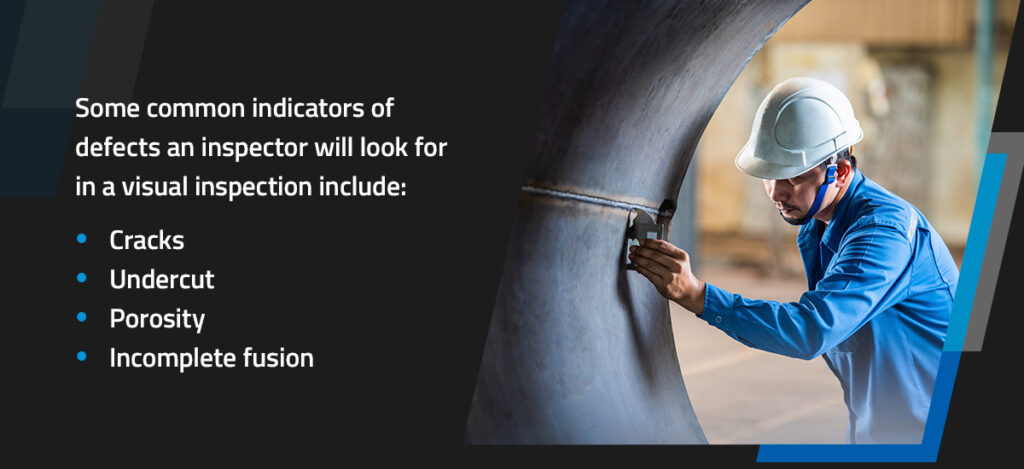Cutting-edge Approaches to Fillet Weld Evaluation and Testing: Enhancing Weld High Quality and Compliance Specifications
In the world of welding, the high quality and stability of fillet welds play a crucial role in guaranteeing the structural sturdiness and integrity of different commercial elements. With the constant drive for improved efficiency and conformity with stringent standards, the expedition of cutting-edge approaches to fillet weld inspection and testing has become crucial. As markets progress, the standard techniques may no much longer be adequate in fulfilling the needs of contemporary welding applications. By embracing advanced technologies and approaches, a brand-new perspective of possibilities emerges in the realm of weld quality assessment and adherence to conformity requirements.
Advanced Non-Destructive Testing Approaches
Making use of modern innovations, progressed non-destructive testing methods play a critical function in making sure the integrity and quality of fillet welds. These techniques, such as phased range ultrasonic screening (PAUT) and magnetic bit testing (MPT), offer detailed understandings right into the weld's inner framework without triggering any damages to the material. PAUT, for example, uses multiple ultrasonic components to check the weld from numerous angles, supplying an extensive visualization of possible defects like absence of fusion or splits.
By using these sophisticated non-destructive testing techniques, weld inspectors can properly examine the high quality of fillet welds, guaranteeing compliance with sector requirements and policies. The ability to detect flaws early on not just improves weld quality but additionally stops expensive rework or failures in architectural honesty, highlighting the importance of these innovative screening strategies in welding assessments.
Robotics and Automation in Examination
The combination of robotics and automation has revolutionized the inspection procedure for fillet welds, improving efficiency and precision in top quality assessment. Robotics provide exact control and repeatability in checking welds, making sure regular and reliable results. Automated systems can be programmed to follow specific inspection courses, making sure detailed coverage of welds and minimizing the danger of human error.
Robot assessment systems geared up with innovative sensors can detect and gauge weld features with high accuracy, offering thorough data for evaluation. These systems can determine defects such as splits, lack of fusion, and porosity, making it possible for punctual restorative actions to be taken. Furthermore, robotics and automation enable real-time information collection and analysis, giving immediate comments to drivers and assisting in fast decision-making procedures.
Moreover, the usage of robotics and automation in fillet weld inspection enhances general performance by decreasing assessment times and boosting evaluation throughput. By simplifying the examination process, makers can make certain weld quality and compliance standards are satisfied effectively, inevitably leading to cost savings and improved item high quality.
Using Expert System for Evaluation
Synthetic intelligence plays an essential function in boosting the effectiveness and precision of evaluation in fillet weld examination processes. AI formulas can rapidly process large quantities of data from weld inspections, detecting flaws or disparities that might be challenging to determine with the nude eye - Welding Inspection Racine.
Furthermore, AI systems can pick up from previous examination data, continuously boosting their ability to determine possible defects and variances in fillet welds. This flexible learning capability improves the general top quality control procedure, reducing the possibility of human mistake and making certain that welds fulfill the required standards. By integrating synthetic knowledge right into fillet weld evaluation, sectors can attain higher levels of effectiveness, uniformity, and conformity in their examination practices.
Portable Tools for On-Site Assessment
 Enhancing field evaluation effectiveness, the fostering of mobile devices changes on-site assessment processes for fillet welds. These tools provide versatility and ease, permitting inspectors to conduct extensive exams in various locations, including difficult or remote settings. Portable tools such as ultrasonic testing gadgets, magnetic bit assessment equipment, and digital radiography systems supply real-time information and high-resolution imaging capacities, making it possible for fast decision-making and prompt responses on weld top quality.
Enhancing field evaluation effectiveness, the fostering of mobile devices changes on-site assessment processes for fillet welds. These tools provide versatility and ease, permitting inspectors to conduct extensive exams in various locations, including difficult or remote settings. Portable tools such as ultrasonic testing gadgets, magnetic bit assessment equipment, and digital radiography systems supply real-time information and high-resolution imaging capacities, making it possible for fast decision-making and prompt responses on weld top quality.One significant benefit of mobile have a peek at these guys devices is their capacity to simplify inspection procedures, lowering downtime and enhancing overall productivity. Examiners can quickly carry these tools to various task websites, getting rid of the requirement for moving hefty equipment or elements to off-site centers. Furthermore, the mobility of these tools advertises cost-effectiveness by lessening transportation costs and speeding up evaluation timelines.
Additionally, using portable tools for on-site inspection advertises positive quality assurance measures, as assessors can without delay recognize and attend to any potential welding defects or inconsistencies. By including these ingenious technologies right into on-site assessment methods, welding professionals can make certain conformity with industry requirements and enhance weld top quality, ultimately leading to boosted structural integrity and safety and security in different welding applications.
Assimilation of Data Administration Equipment
Having enhanced on-site inspection processes with the utilization of portable tools, the following phase includes the smooth useful link assimilation of data administration systems to better enhance effectiveness and information analysis capabilities in fillet weld examination and screening. Welding Inspection Racine. By integrating data monitoring systems into the assessment procedure, organizations can improve information collection, storage, and analysis. This combination allows for real-time monitoring of weld high quality, instant recognition of problems, and timely decision-making to fix any concerns that might develop during the assessment process
The integration of information administration systems enables seamless interaction in between different stakeholders entailed in the evaluation procedure, fostering cooperation and enhancing total quality control procedures. Ultimately, the assimilation of data monitoring systems serves to raise the standards of fillet weld assessment and screening, making sure conformity with industry guidelines and enhancing weld top quality.
Conclusion
To conclude, innovative strategies to fillet weld examination and testing have actually substantially enhanced weld quality and conformity standards. Advanced non-destructive testing techniques, robotics, automation, synthetic knowledge, portable devices, and information administration systems have actually transformed the method weld examinations are conducted. By utilizing these innovations, sectors can guarantee that welds satisfy the called for quality standards and guidelines, inevitably improving general performance and safety in welding procedures.

By employing these advanced non-destructive testing methods, weld examiners can precisely analyze the top quality of fillet welds, ensuring compliance with industry standards and policies. Mobile devices such as ultrasonic screening tools, magnetic fragment examination tools, and electronic radiography systems give real-time information and high-resolution imaging capacities, enabling fast decision-making and immediate feedback on weld top quality.
Having actually Web Site enhanced on-site evaluation processes via the application of mobile tools, the next stage includes the seamless integration of information administration systems to even more enhance performance and information analysis capacities in fillet weld assessment and testing (Welding Inspection Racine). Ultimately, the assimilation of data management systems offers to raise the standards of fillet weld inspection and screening, guaranteeing conformity with market policies and boosting weld quality
 In final thought, cutting-edge approaches to fillet weld evaluation and testing have substantially enhanced weld quality and compliance requirements.
In final thought, cutting-edge approaches to fillet weld evaluation and testing have substantially enhanced weld quality and compliance requirements.